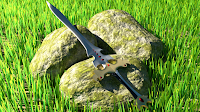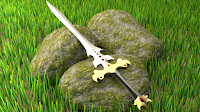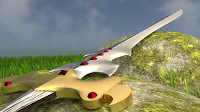Concept:
Themes -
-Invention and fantasy: create amazing, imaginary worlds and enjoyable characters.-War: weapon design, armor, war environments.
Integration -
-Main work adhere to themes such as characters and environment with fantasy, but also my sketchbook pages are basically investigations on how to pull my goal off (Better Lighting, World-Building, Weapons, Armor, Character Creation, Proportion).
Concentration:
-3D Modeling, 3D Animation, and 2D Design
Production:
-Modeled a sword and arrow/spear I intend to use in an animation later on. (Still learning the basics of animation to pull this off.)
-Drew concepts of characters I intend to model in Blender (and attempt to animate).
Breadth:
-Sketches with different medias, poses, and objects.
-Blender for modeling and animation.
-Attempted Photoshop for concept art.
Evaluation, Integration, and Choices:
Sketches -
Strengths: fixing mistakes, drawing figures/objects, easy and quick to do
Weaknesses: turning it digital for further use
Choice: try concept art digitally for easier access
Strengths: on the computer, used a sketch as a base, very good at selection tools (XD)
Weaknesses: I have no clue what I am doing on this foreign equipment
Choice: Give up and free-hand on Blender or just scan sketches... I shall try and figure this out before the school year ends though
Blender -
Strengths: I know what I am doing!!, it is my preferred media and is my finished product for all the preparation of the two above, I can model and animate (Hypnosis) and use my concepts, I am also pretty proud of my node editor abilities so make amazing materials/textures
Weaknesses: still learning stuff XD
Choice: Suck it up and learn
Intention, Definition, and Exploration of Ideas:
-My focus on Blender stems from the want of creating worlds and characters that can then come to life with animation. The goal of learning these skills is to make video games or animated stories. Blender is the best choice to explore these desires because it is similar to the system video game companies and professionals use to produce their work. Also, sketching and digital programs such as Photoshop and the drawing tablet will help with the conceptual designs of my finished Blender projects.
Planning:
-My plan is to first make conceptual designs of characters and an environment. The next step would be to model these ideas in Blender and render images of the finished product. Then I would like to rig it and animate a scene. After all of this, I want to figure out Blender game engine and see how I could make a simple video game in Blender (or just program one with different software). While I attempt all of these goals, I would like to run into mistakes or problems so I may learn from them and make my art better.
Producing:
-So far I have made some concept designs and have modeled some weapons, grass, a sky, rocks, and have been practicing lighting and camera positions.
Evaluating:
-So far I hope I am on the right track. I have played with many different options and have already learned some valuable lessons.
Integrating:
-I have already learned from some mistakes when it comes to rendering images in Blender. Also I have more knowledge in Photoshop and I used prior use of my tablet to help (though I still failed pretty hardcore).


 To the left is a render at 1000 and the right is a render of 2000.
To the left is a render at 1000 and the right is a render of 2000.Then I realized the horrors of my lighting, so I went back and created proper 3-point lighting and re-rendered at 2000 (bottom left).
The outcome was so much better that I moved on and attempted another angle (with sky!).

















